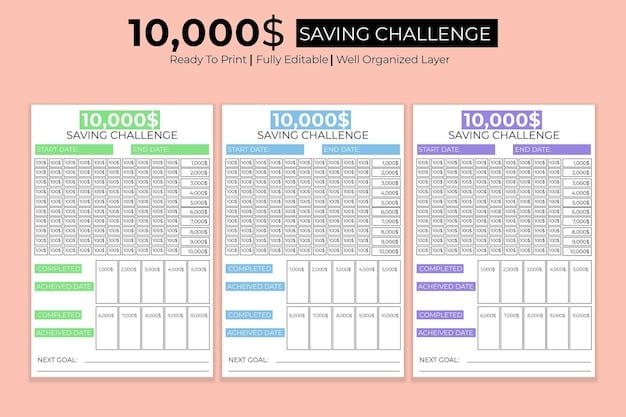Zero-Based Budgeting: Master Your Finances in 3 Months

Zero-based budgeting is a financial strategy where every dollar is allocated anew each month, starting from zero, ensuring that all expenses are justified and aligned with your financial goals over the next three months.
Are you feeling financially adrift? Do you want a straightforward method to regain control of your spending and savings? Zero-based budgeting: A practical guide to reclaiming control of your finances in the next 3 months, is an effective approach that can transform your financial situation.
What is Zero-Based Budgeting?
Zero-based budgeting (ZBB) is a method of budgeting in which all expenses must be justified for each new period. The “zero-base” refers to the idea that instead of starting with last year’s budget and making adjustments, you start from scratch, justifying every expense.
This approach forces you to evaluate each expense and decide whether it is truly necessary. It’s a more active and conscious way of managing your money compared to traditional budgeting methods, where you might simply roll over previous budgets with minor modifications.
Key principles of zero-based budgeting
- Start from Zero: Every budgeting period starts with a clean slate.
- Justify Every Expense: Every expense, regardless of how small, must be justified and approved.
- Prioritize Needs: Focus on essential needs first and then allocate funds to wants based on available resources.
- Regular Review: Budget is reviewed and adjusted regularly to reflect changes in circumstances.

Ultimately, zero-based budgeting provides a clear understanding of where your money is going and ensures that it aligns with your financial goals. It’s not just about cutting expenses; it’s about making deliberate choices about how to use your money.
Benefits of Adopting a Zero-Based Budget
Adopting a zero-based budget can bring about significant improvements in your financial management. By taking a more hands-on approach, you gain greater awareness and control over your financial resources.
The benefits are not limited to just saving money; they extend to improving your overall financial health and decision-making.
Increased Financial Awareness
One of the primary benefits of zero-based budgeting is increased financial awareness. When you are required to justify every expense, you become more conscious of where your money is going.
This heightened awareness can lead to better spending habits and a more informed approach to financial planning.
Better Control Over Spending
Zero-based budgeting gives you better control over your spending by making you accountable for every dollar spent. You are actively deciding where your money should go, rather than passively letting it slip away.
This level of control can be particularly useful for those who tend to overspend or struggle with impulse purchases.
- Eliminates unnecessary expenses
- Helps prioritize financial goals
- Provides real-time feedback on spending patterns
In conclusion, zero-based budgeting empowers you to take charge of your finances, make informed decisions, and work towards your financial objectives more effectively.
How to Implement Zero-Based Budgeting
Implementing a zero-based budget involves a structured process that requires dedication and attention to detail. By following a step-by-step approach, you can successfully adopt this budgeting method and start seeing positive changes in your financial situation.
The key is to be thorough, honest with yourself, and committed to the process.
Step 1: Calculate Your Total Income
The first step in implementing zero-based budgeting is to determine your total income for the budgeting period. This includes all sources of income, such as salary, wages, investment income, and any other regular sources of funds.
Having an accurate figure of your income is crucial as it forms the basis for allocating your budget.
Step 2: List All Your Expenses
Next, you need to list all your expenses. Include both fixed expenses, such as rent or mortgage payments, and variable expenses, such as groceries and entertainment.
Be as comprehensive as possible, as this will give you a clear picture of your spending habits. Use bank statements, credit card bills, and receipts to track your expenses accurately.
Step 3: Categorize and Prioritize Expenses
Once you have listed all your expenses, categorize them into needs and wants. Prioritize your needs, such as housing, food, and transportation, and then consider your wants, such as dining out and entertainment.
This prioritization will help you make informed decisions about where to allocate your funds.
- Needs: rent/mortgage, utilities, groceries, transportation, insurance
- Wants: dining out, subscriptions, entertainment, hobbies
Implementing zero-based budgeting requires a systematic and thoughtful approach. By following these steps, you can effectively manage your finances, eliminate unnecessary expenses, and align your spending with your financial goals.
Tools to Make Zero-Based Budgeting Easier
While the concept of zero-based budgeting is straightforward, the execution can be made easier and more efficient with the right tools.
These tools can help you track your income and expenses, manage your budget, and provide insights into your spending patterns.
Spreadsheet Software
Spreadsheet software, such as Microsoft Excel or Google Sheets, is a versatile tool for zero-based budgeting. You can create custom spreadsheets to track your income, expenses, and budget allocations.
Spreadsheets allow you to easily visualize your data, perform calculations, and make adjustments to your budget as needed.
Budgeting Apps
There are numerous budgeting apps available that are specifically designed to help you manage your finances. These apps often come with features such as automatic expense tracking, budget planning tools, and financial goal setting.
Some popular budgeting apps include Mint, YNAB (You Need a Budget), and Personal Capital.

- Automated expense tracking
- Budget planning and management
- Goal setting and progress tracking
In summary, utilizing the right tools can significantly streamline the zero-based budgeting process, making it more manageable and effective. Choose the tools that best fit your needs and take advantage of their features to improve your financial management.
Overcoming Common Challenges in Zero-Based Budgeting
While zero-based budgeting offers many benefits, it’s not without its challenges. Many people who try implementing this budgeting method encounter obstacles that can make it difficult to stick to.
Understanding these challenges and knowing how to overcome them is key to successfully adopting and maintaining a zero-based budget.
Inaccurate Income and Expense Tracking
One of the most common challenges is inaccurate tracking of income and expenses. If you don’t have a clear picture of how much money you’re earning and spending, it’s difficult to create an effective budget.
To overcome this, dedicate time each week to review your financial transactions and ensure that you are accurately recording all income and expenses.
Overly Restrictive Budget
Another challenge is creating an overly restrictive budget that doesn’t allow for any flexibility. While it’s important to cut unnecessary expenses, it’s also important to allow yourself some spending money for enjoyment.
An overly restrictive budget can lead to burnout and make it difficult to stick to your budget in the long run.
- Allow for flexible spending
- Set realistic goals
- Track progress regularly
By addressing these challenges head-on, you can increase your chances of successfully implementing and maintaining a zero-based budget.
Achieving Financial Goals with Zero-Based Budgeting
Zero-based budgeting is more than just a way to track expenses; it’s a powerful tool for achieving your financial goals. By actively managing your money and aligning your spending with your priorities, you can make significant progress towards your long-term financial objectives.
Whether you’re saving for a down payment on a house, paying off debt, or investing for retirement, zero-based budgeting can help you get there faster.
Saving for a Down Payment
If you’re saving for a down payment on a house, zero-based budgeting can help you identify areas where you can cut expenses and allocate more funds towards your savings goal.
By setting a specific savings target and tracking your progress, you can stay motivated and on track.
Paying off Debt
Zero-based budgeting can be particularly effective for paying off debt. By allocating a specific amount each month towards debt repayment, you can steadily reduce your debt balance and save on interest payments.
Prioritize high-interest debt, such as credit card debt, and consider using the debt snowball or debt avalanche method to accelerate your repayment.
- Consistently allocate funds to savings goals
- Monitor progress to stay motivated
In conclusion, zero-based budgeting is a powerful tool that can help you achieve your financial goals. By actively managing your money and aligning your spending with your objectives, you can take control of your financial future and build a more secure and prosperous life.
| Key Point | Brief Description |
|---|---|
| 💰 What is ZBB? | Budgeting from zero each period, justifying all expenses. |
| ✅ Implementation Steps | Calculate income, list expenses, and prioritize needs vs. wants. |
| 🎯 Financial Goals | Use ZBB to achieve savings, pay off debt, and invest. |
| 🛠️ Useful Tools | Use software and apps for better tracking and management. |
FAQ
▼
In zero-based budgeting, you start from zero each month and justify every expense. Traditional budgeting usually adjusts the previous budget, potentially overlooking unnecessary costs.
▼
You should review your zero-based budget at least monthly, but weekly reviews can help you stay on track and quickly identify any deviations from your plan.
▼
If expenses exceed income, identify non-essential costs to cut. Consider temporary increases in income through part-time work or selling unwanted items to balance your budget.
▼
Yes, allocate a portion of your monthly budget to a sinking fund for large, infrequent expenses like car repairs or holiday gifts. This prevents financial surprises.
▼
Yes, estimate your income conservatively at the start of each month. Prioritize essential expenses and adjust the budget based on your actual income as it comes in.
Conclusion
In conclusion, zero-based budgeting is a powerful tool to reclaim control of your finances. By justifying every expense and aligning your spending with your priorities, you can achieve your financial goals within the next three months and beyond.




